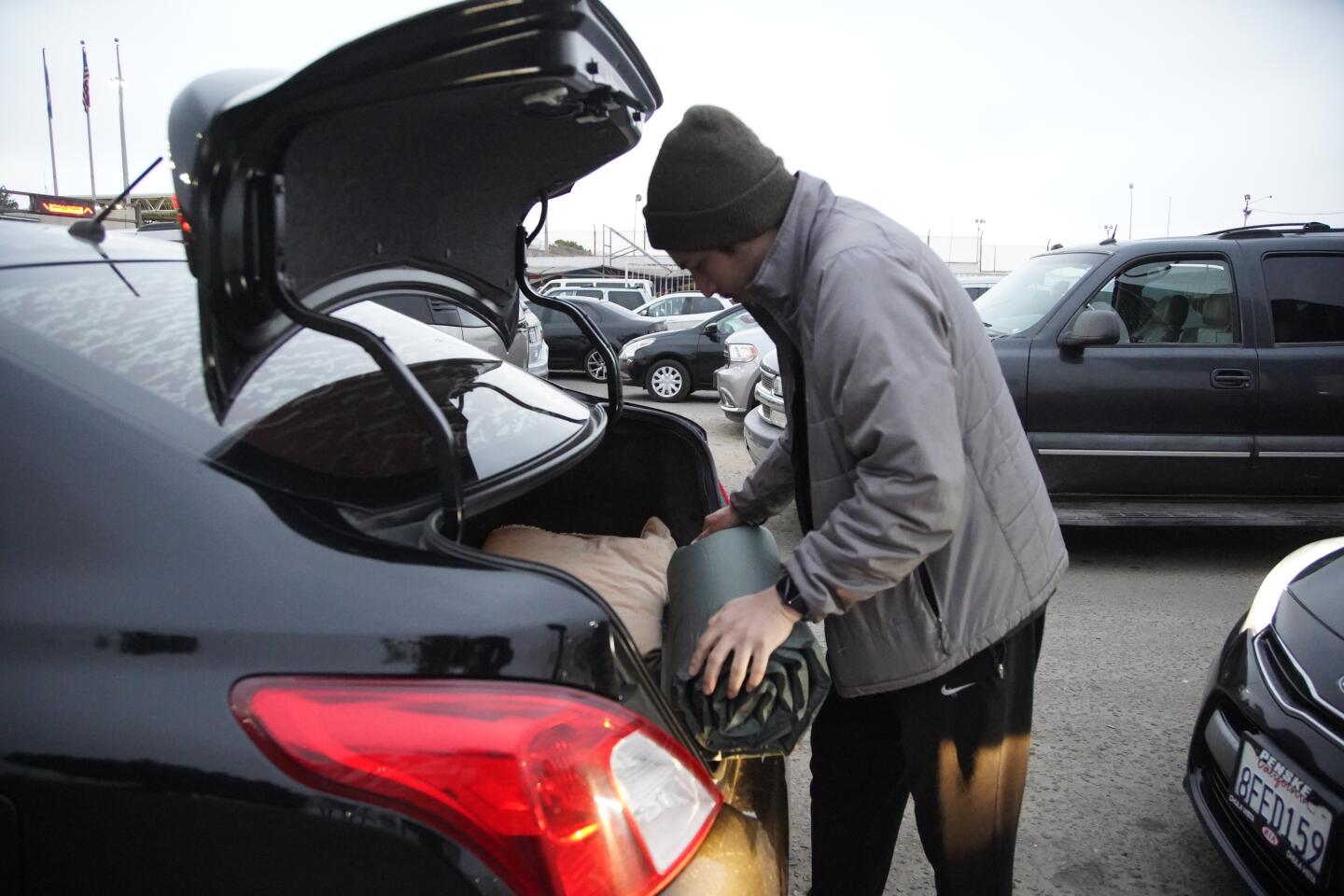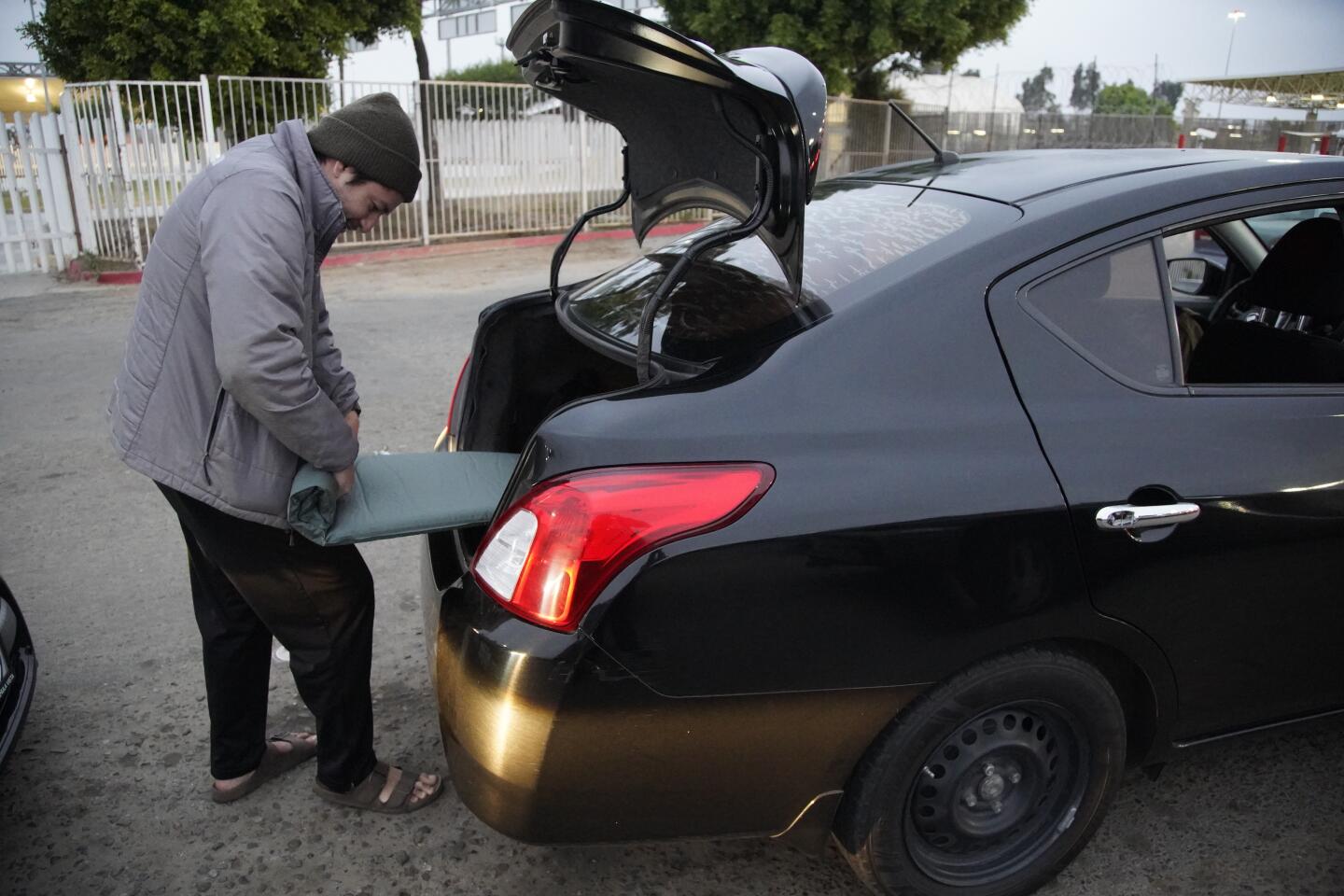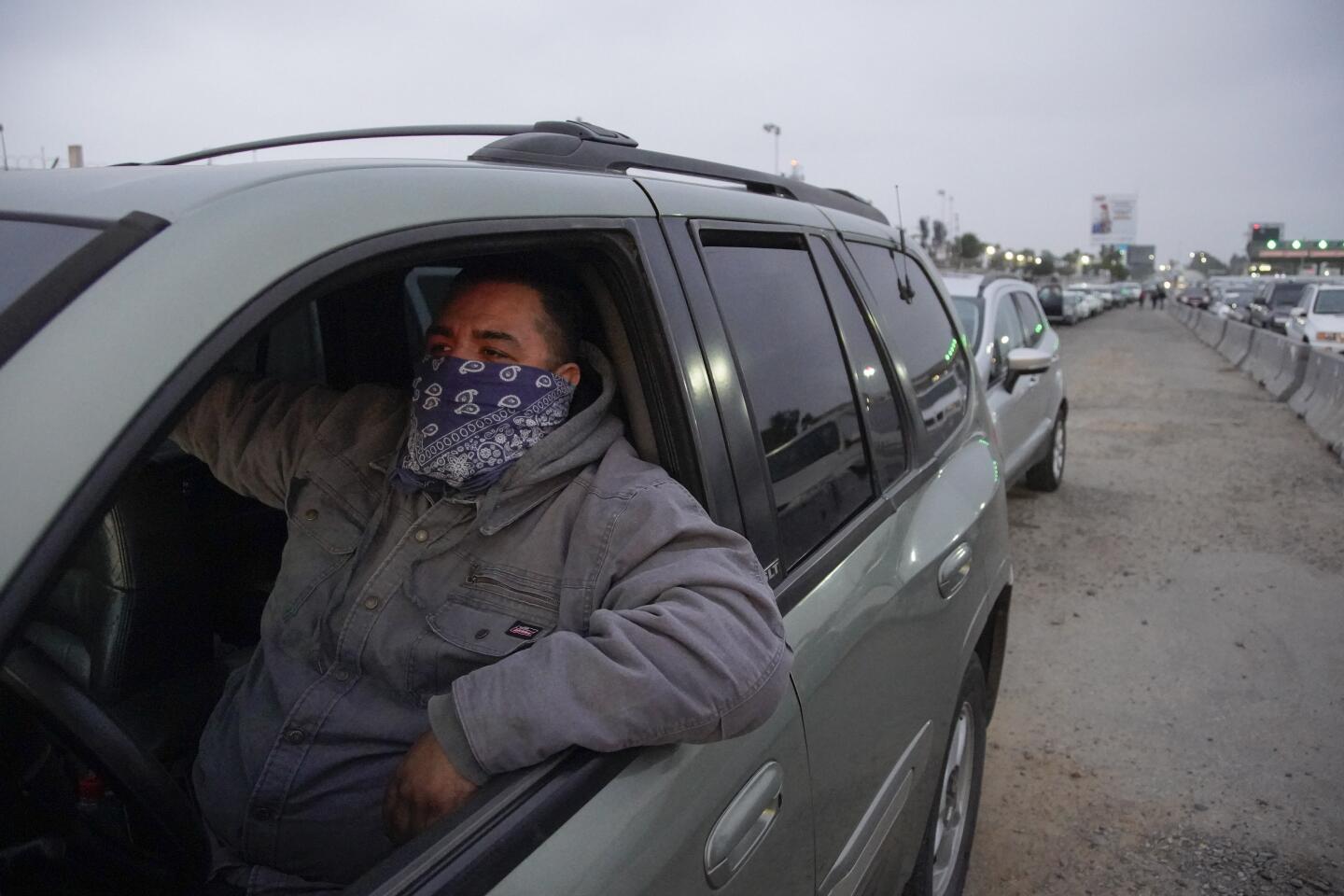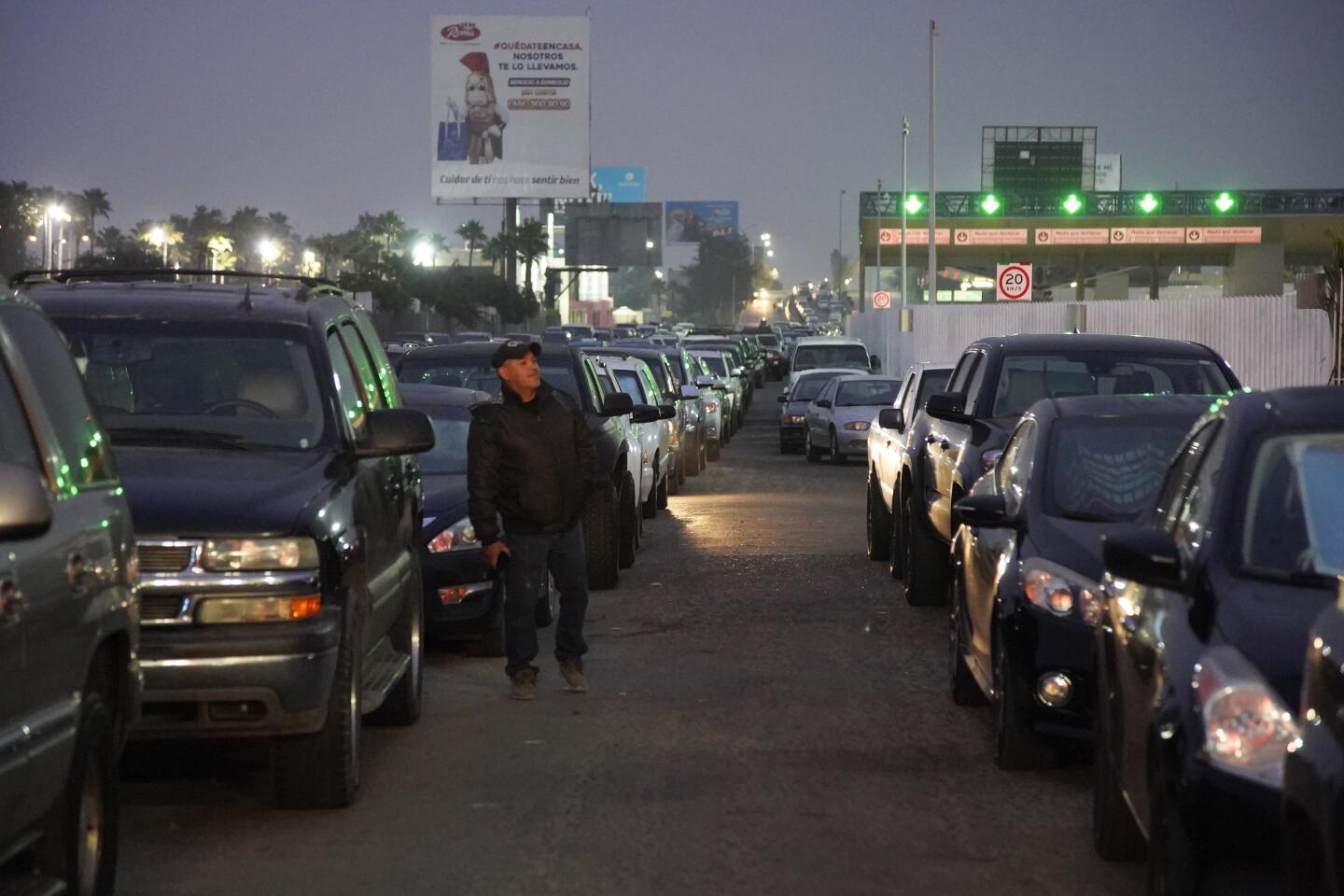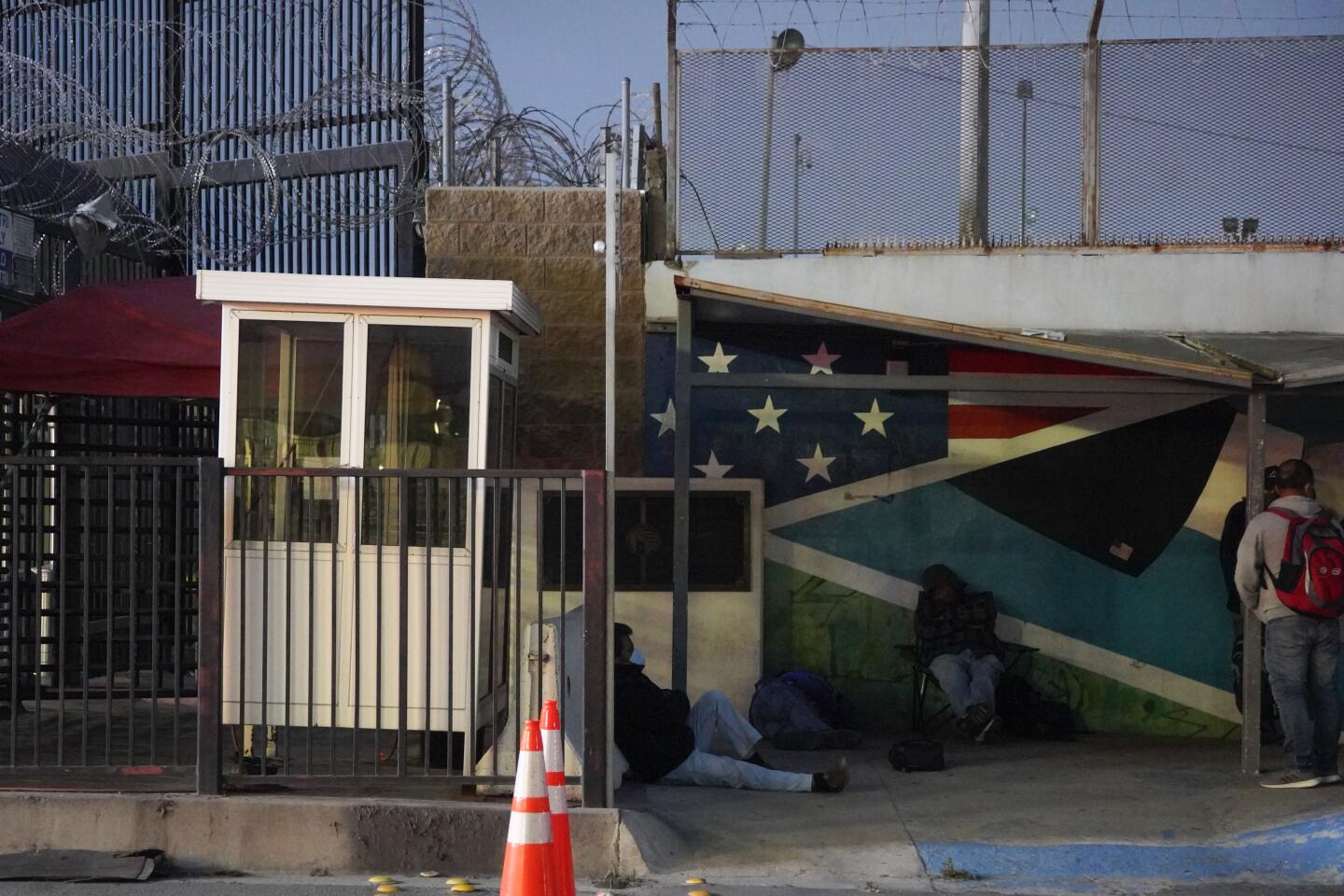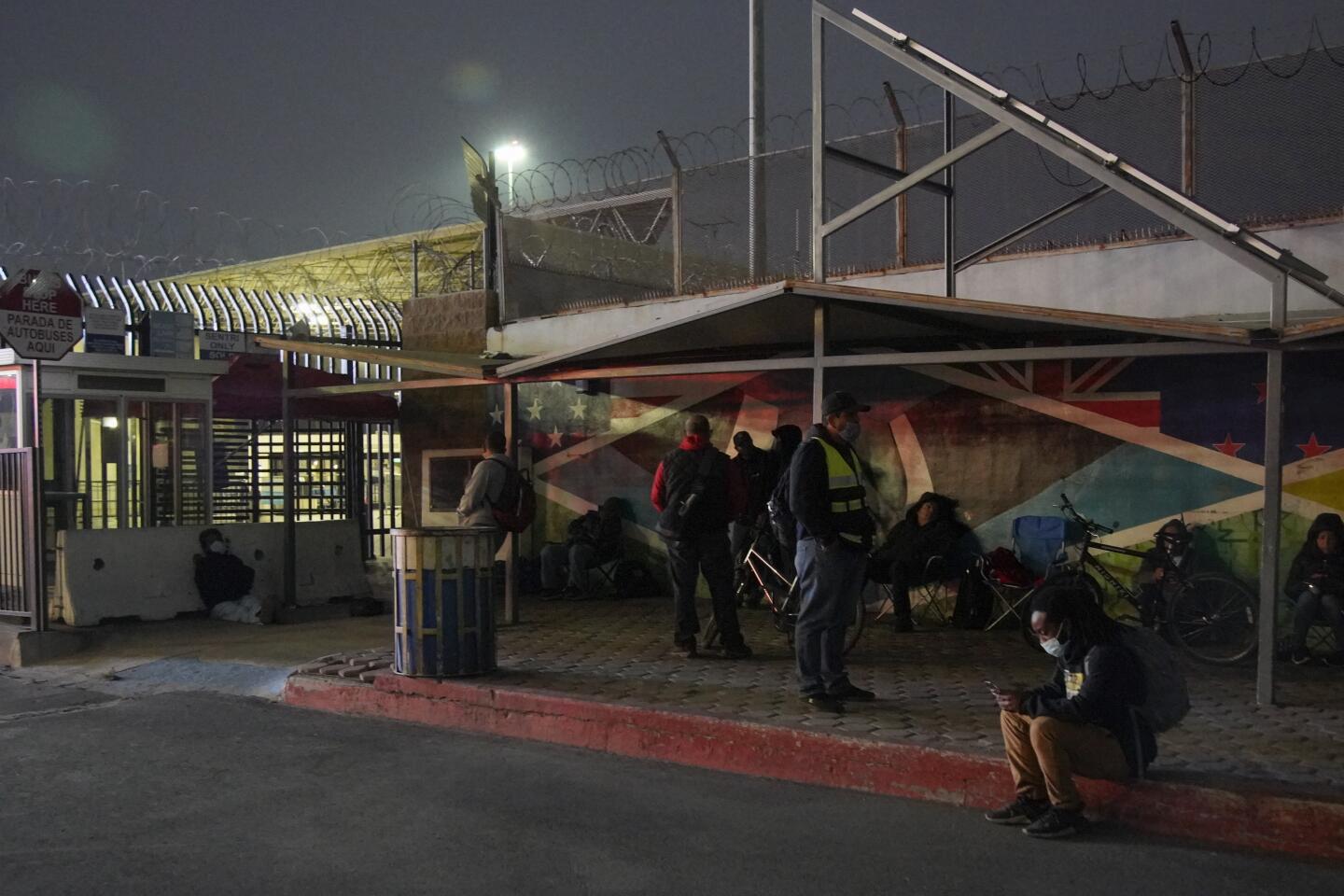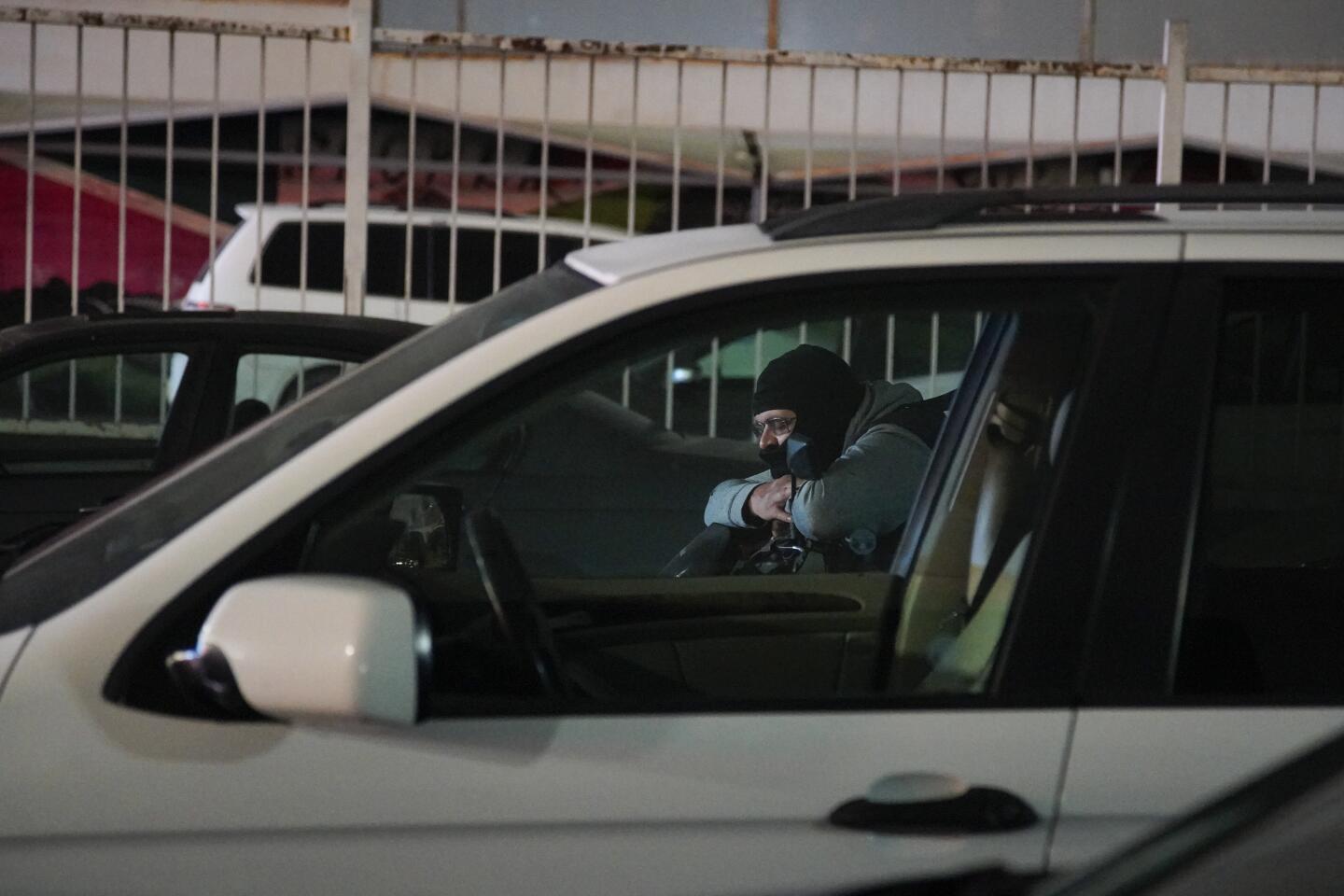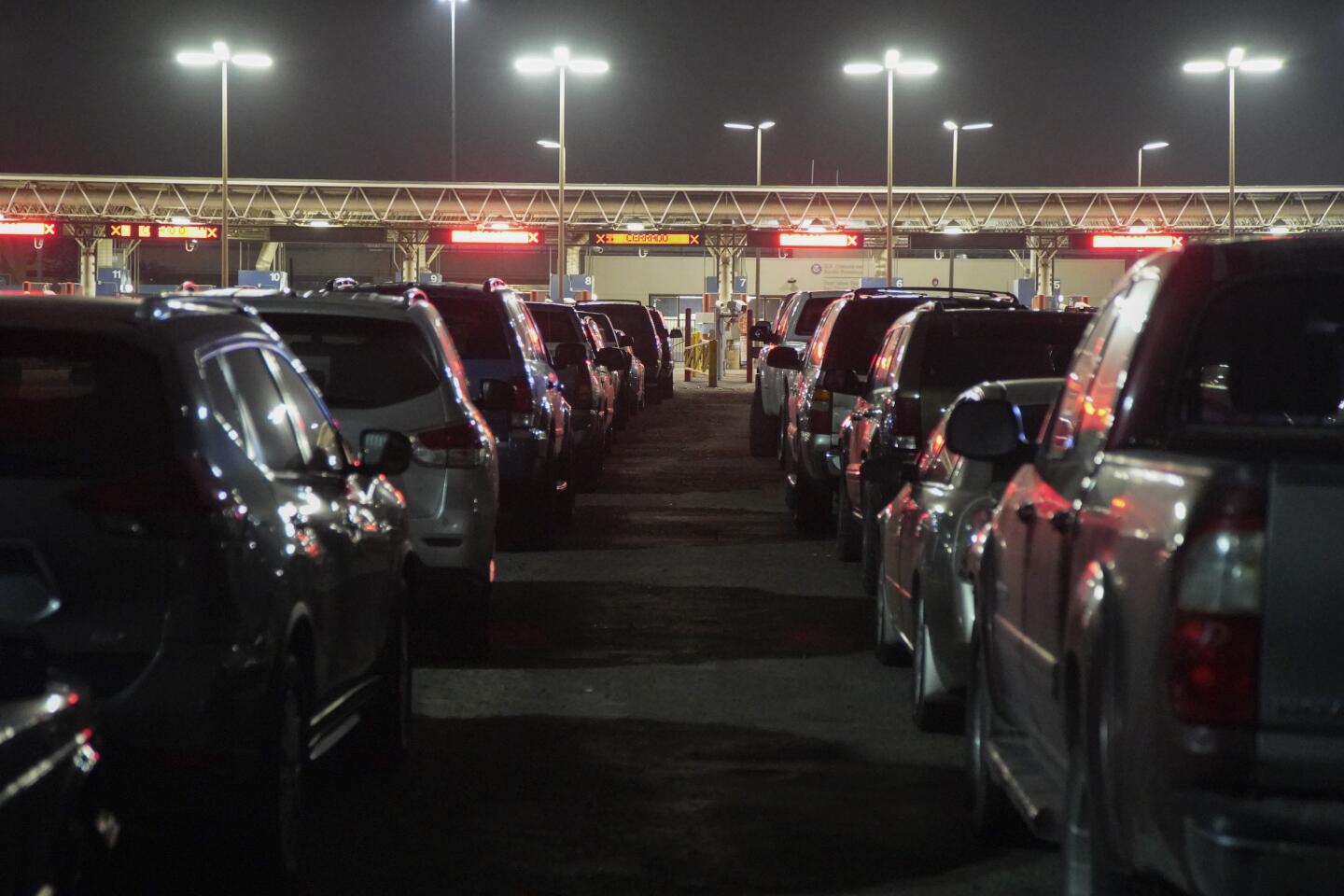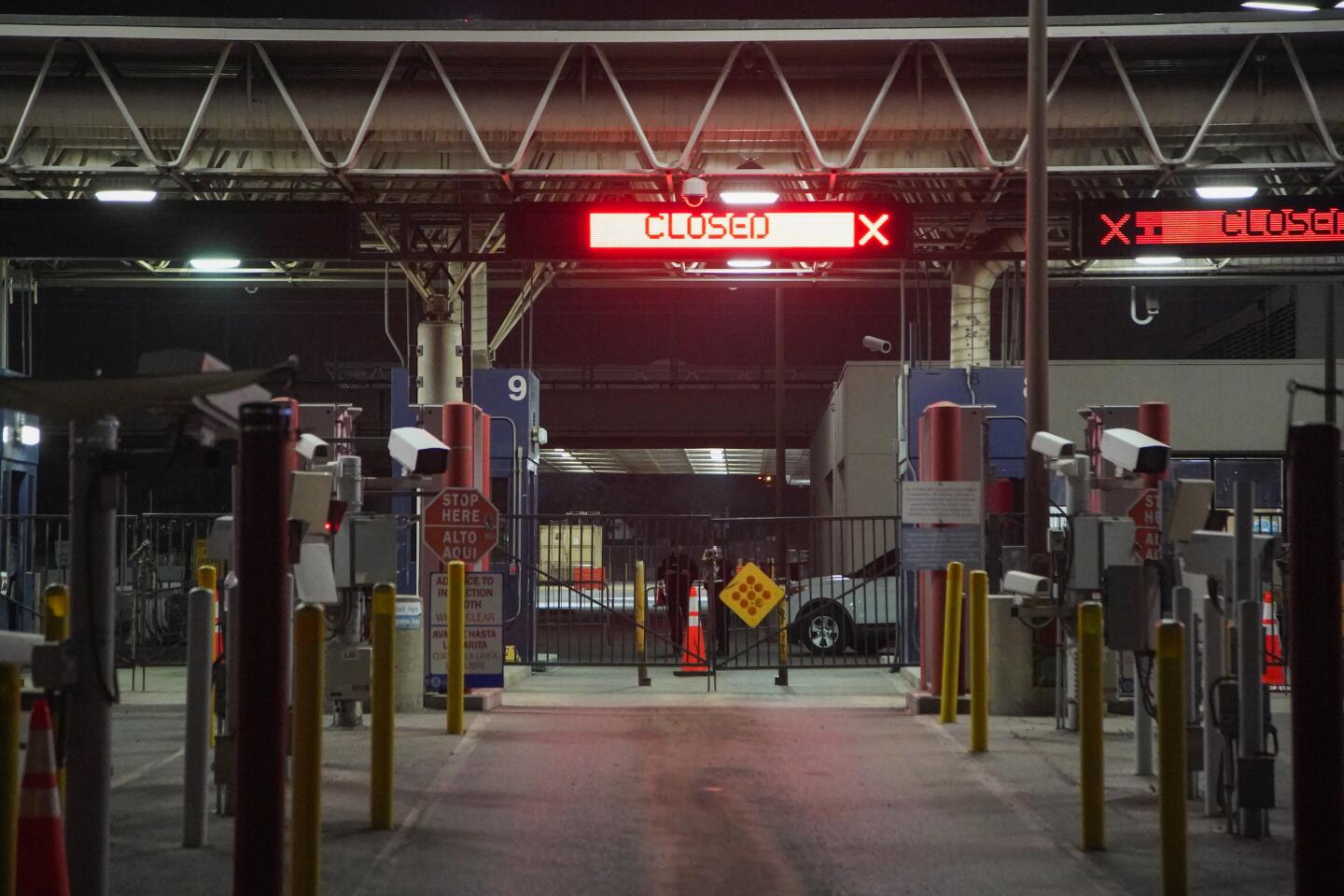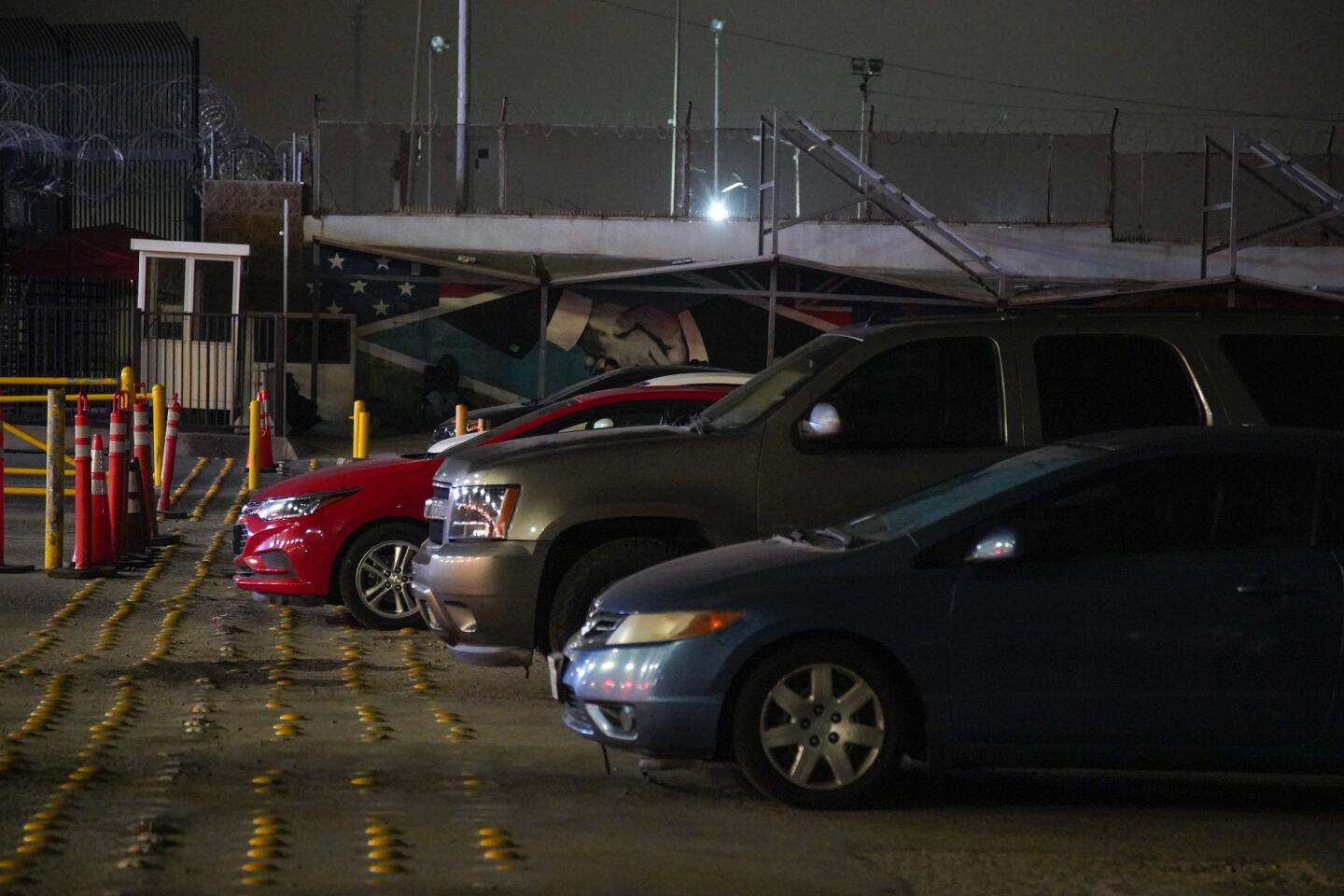TIJUANA — Dozens of cross-border workers are sleeping on the sidewalk or inside their cars to be among the first enter the United States once the Otay Mesa Port of Entry opens each morning.
The scene has played out ever since this busy border crossing, which previously operated 24 hours a day, temporarily suspended operations at night.
Being late to work isn’t an option for these workers, so they prefer a bad sleepover to the unpredictable wait times at the other port of entry in San Ysidro.
Since the beginning of May, the Otay Mesa Port of Entry has been operating from 6 a.m. to 10 p.m. The reduction in hours comes as restrictions against nonessential travel at the border have decreased northbound traffic.
That has pushed nighttime and early morning border traffic in the Tijuana-San Diego region to the San Ysidro Port of Entry, which remains open 24 hours, although it has been operating with fewer lanes for several weeks now.
Some workers tried to shift from Otay Mesa to San Ysidro but encountered longer wait times.
“We cannot rely on border wait times,” said Porfirio Perez, a mechanic who works in San Diego.
So he arrived at the Otay Mesa Port of Entry at 10:30 p.m. on Thursday night, parked in one of the lanes, and slept inside his car. He has been doing the same thing for three weeks now, and he is getting tired.
“It’s stressful, we barely get any sleep,” he said.
Julio Quintero did the same thing the night before to be on time for work in Chula Vista.
He knows the drill by now. He carries only a blanket, sets the alarm and sleeps in the back of his car. At his work in a flower shop, they allow him to be half an hour late because they know the current border situation.
1/19
Tijuana, Baja California, May 22nd, 2020 | Arturo Munoz 37, motorcycle rider arrived at the border around 5:30am heading to work in San Diego. People have been sleeping in their cars at the Otay border to wait for the port of entry to open; it started happening after the hours of service of the border port of entry were reduced. | (Alejandro Tamayo, The San Diego Union Tribune 2020) (Alejandro Tamayo/Alejandro Tamayo/The San Diego Union Tribune)
2/19
Tijuana, Baja California, May 22nd, 2020 | Speed bumps mark the US and Mexico boundaries. People have been sleeping in their cars at the Otay border to wait for the port of entry to open; it started happening after the hours of service of the border port of entry were reduced. | (Alejandro Tamayo, The San Diego Union Tribune 2020) (Alejandro Tamayo/Alejandro Tamayo/The San Diego Union Tribune)
3/19
Tijuana, Baja California, May 22nd, 2020 | Antonio De Maso 29, Uber driver not working at the moment, waits overnight in line for his mother. He rolls his sleeping bag. People have been sleeping in their cars at the Otay border to wait for the port of entry to open; it started happening after the hours of service of the border port of entry were reduced. | (Alejandro Tamayo, The San Diego Union Tribune 2020) (Alejandro Tamayo/Alejandro Tamayo/The San Diego Union Tribune)
4/19
Tijuana, Baja California, May 22nd, 2020 | Antonio De Maso 29, Uber driver not working at the moment, waits overnight in line for his mother. He rolls his sleeping bag. People have been sleeping in their cars at the Otay border to wait for the port of entry to open; it started happening after the hours of service of the border port of entry were reduced. | (Alejandro Tamayo, The San Diego Union Tribune 2020) (Alejandro Tamayo/Alejandro Tamayo/The San Diego Union Tribune)
5/19
Tijuana, Baja California, May 22nd, 2020 | Jorge Garcia, 35 going to work in Otay Mesa, got in line last night around 10pm. He tried crossing through the San Ysidro border but did not like the long waits and traffic. “I rather wait her over night and not deal with the people cutting the line and stop and go for hours in San Ysidro”. People have been sleeping in their cars at the Otay border to wait for the port of entry to open; it started happening after the hours of service of the border port of entry were reduced. | (Alejandro Tamayo, The San Diego Union Tribune 2020) (Alejandro Tamayo/Alejandro Tamayo/The San Diego Union Tribune)
6/19
Tijuana, Baja California, May 22nd, 2020 | Man gets out of his car as the sun rises. People have been sleeping in their cars at the Otay border to wait for the port of entry to open; it started happening after the hours of service of the border port of entry were reduced. | (Alejandro Tamayo, The San Diego Union Tribune 2020) (Alejandro Tamayo/Alejandro Tamayo/The San Diego Union Tribune)
7/19
Tijuana, Baja California, May 22nd, 2020 | At the pedestrian crossing people sleep in line waiting for the border to open. People have been sleeping in their cars at the Otay border to wait for the port of entry to open; it started happening after the hours of service of the border port of entry were reduced. | (Alejandro Tamayo, The San Diego Union Tribune 2020) (Alejandro Tamayo/Alejandro Tamayo/The San Diego Union Tribune)
8/19
Tijuana, Baja California, May 22nd, 2020 | At the pedestrian crossing people sleep in line waiting for the border to open. People have been sleeping in their cars at the Otay border to wait for the port of entry to open; it started happening after the hours of service of the border port of entry were reduced. | (Alejandro Tamayo, The San Diego Union Tribune 2020) (Alejandro Tamayo/Alejandro Tamayo/The San Diego Union Tribune)
9/19
Tijuana, Baja California, May 22nd, 2020 | Pedestrians sleeping in line while morning business at the border get ready. People have been sleeping in their cars at the Otay border to wait for the port of entry to open; it started happening after the hours of service of the border port of entry were reduced. | (Alejandro Tamayo, The San Diego Union Tribune 2020) (Alejandro Tamayo/Alejandro Tamayo/The San Diego Union Tribune)
10/19
Tijuana, Baja California, May 22nd, 2020 | Salvador Rangel, 35 on his motorcycle is waiting to cross he works as a truck driver in San Diego. People have been sleeping in their cars at the Otay border to wait for the port of entry to open; it started happening after the hours of service of the border port of entry were reduced. | (Alejandro Tamayo, The San Diego Union Tribune 2020) (Alejandro Tamayo/Alejandro Tamayo/The San Diego Union Tribune)
11/19
Tijuana, Baja California, May 22nd, 2020 | On his cell phone Ricardo Alamo Roque 25, arrived at 10:20pm, He lost his job during the pandemic and now helps out his sister waiting in line overnight. People have been sleeping in their cars at the Otay border to wait for the port of entry to open; it started happening after the hours of service of the border port of entry were reduced. | (Alejandro Tamayo, The San Diego Union Tribune 2020) (Alejandro Tamayo/Alejandro Tamayo/The San Diego Union Tribune)
12/19
Tijuana, Baja California, May 22nd, 2020 | Man sleeping in his truck, waiting for the border to open. People have been sleeping in their cars at the Otay border to wait for the port of entry to open; it started happening after the hours of service of the border port of entry were reduced. | (Alejandro Tamayo, The San Diego Union Tribune 2020) (Alejandro Tamayo/Alejandro Tamayo/The San Diego Union Tribune)
13/19
Tijuana, Baja California, May 22nd, 2020 | Hundreds of cars wait in line for the border to open. Some sleep in theirs cars, other arrive later to pick up their car. People have been sleeping in their cars at the Otay border to wait for the port of entry to open; it started happening after the hours of service of the border port of entry were reduced. | (Alejandro Tamayo, The San Diego Union Tribune 2020) (Alejandro Tamayo/Alejandro Tamayo/The San Diego Union Tribune)
14/19
Tijuana, Baja California, May 22nd, 2020 | Salvador Rangel, 35 on his motorcycle is waiting to cross he works as a truck driver in San Diego. People have been sleeping in their cars at the Otay border to wait for the port of entry to open; it started happening after the hours of service of the border port of entry were reduced. | (Alejandro Tamayo, The San Diego Union Tribune 2020) (Alejandro Tamayo/Alejandro Tamayo/The San Diego Union Tribune)
15/19
Tijuana, Baja California, May 22nd, 2020 | At the pedestrian crossing people sleep in line waiting for the border to open. People have been sleeping in their cars at the Otay border to wait for the port of entry to open; it started happening after the hours of service of the border port of entry were reduced. | (Alejandro Tamayo, The San Diego Union Tribune 2020) (Alejandro Tamayo/Alejandro Tamayo/The San Diego Union Tribune)
16/19
Tijuana, Baja California, May 22nd, 2020 | Hundreds of cars wait in line for the border to open. Some sleep in theirs cars, other arrive later to pick up their car. People have been sleeping in their cars at the Otay border to wait for the port of entry to open; it started happening after the hours of service of the border port of entry were reduced. | (Alejandro Tamayo, The San Diego Union Tribune 2020) (Alejandro Tamayo/Alejandro Tamayo/The San Diego Union Tribune)
17/19
Tijuana, Baja California, May 22nd, 2020 | Hundreds of cars wait in line for the border to open. Some sleep in theirs cars, other arrive later to pick up their car. People have been sleeping in their cars at the Otay border to wait for the port of entry to open; it started happening after the hours of service of the border port of entry were reduced. | (Alejandro Tamayo, The San Diego Union Tribune 2020) (Alejandro Tamayo/Alejandro Tamayo/The San Diego Union Tribune)
18/19
Tijuana, Baja California, May 22nd, 2020 | All gates are closed till six in the morning. People have been sleeping in their cars at the Otay border to wait for the port of entry to open; it started happening after the hours of service of the border port of entry were reduced. | (Alejandro Tamayo, The San Diego Union Tribune 2020) (Alejandro Tamayo/Alejandro Tamayo/The San Diego Union Tribune)
19/19
Tijuana, Baja California, May 22nd, 2020 | Cars that wait at the front of the line arrived around 10pm the night before. People have been sleeping in their cars at the Otay border to wait for the port of entry to open; it started happening after the hours of service of the border port of entry were reduced. | (Alejandro Tamayo, The San Diego Union Tribune 2020) (Alejandro Tamayo/Alejandro Tamayo/The San Diego Union Tribune)
He once tried to cross through San Ysidro, but the line seemed endless, he said. It’s better to at least have some sleep rather than spend the night in line wasting gas, he reasoned.
“It’s very tiring, but what else can we do?” asked Quintero.
Other workers who live near the Otay Mesa Port of Entry prefer to park their cars at night in the line, go home to sleep and return to them minutes before the port opens at 6 a.m. But Quintero says that’s not a good idea.
At the pedestrian crossing, dozens sleep either in folding chairs or in the sidewalk covered by blankets.
Javier Sánchez, a construction worker, adopted this routine last week and said the most tiring part is not knowing how long it will take to get everything back to normal.
The U.S. and Mexican governments agreed this past week to extend the border travel restrictions through at least June 22. The border crossings are open for U.S. citizens, legal permanent residents, people with work visas, and those traveling for education or medical reasons, among other reasons deemed essential. Crossings remain closed for recreational and tourist travel.
Gustavo de la Fuente, executive director of the Smart Border Coalition, said he believes U.S. authorities should monitor the wait times as businesses reopen.
“Just as businesses keep reopening or accepting more employees inside their facilities in San Diego, the border wait times will continue to increase,” he said.
U.S. Customs and Border Protection acknowledged that travelers may face increased wait times in passenger and commercial operations due to restricted crossings and temporary closures of processing lanes.
“We monitor and make operational adjustments daily, depending on the totality of the workload we have at each port. While the nonessential travel restrictions are in place, we are focused on maintaining wait times for workers crossing during the weekday morning peak hours similar to what they were before the restrictions came into effect,” the agency said in a statement.
In the meantime, some cross-border workers consider other options.
David Ramos, who works at a veterans’ home in San Diego, prefers to cross through San Ysidro at night, then sleep.
“I don’t see the point of staying a few feet away from the port of entry when you can cross at night and sleep at or near your work,” he said.
Meanwhile, mornings have taken on a new routine at the Otay Mesa border. The cellphone alarms start ringing about 5:30 a.m.
By 5:55 a.m., car engines are turned on and pedestrians get ready with their documents. And at 6 a.m., dozens of workers begin to move knowing that — at least for now — they will have to do this all over again.
Mendoza writes for the San Diego Union-Tribune.



